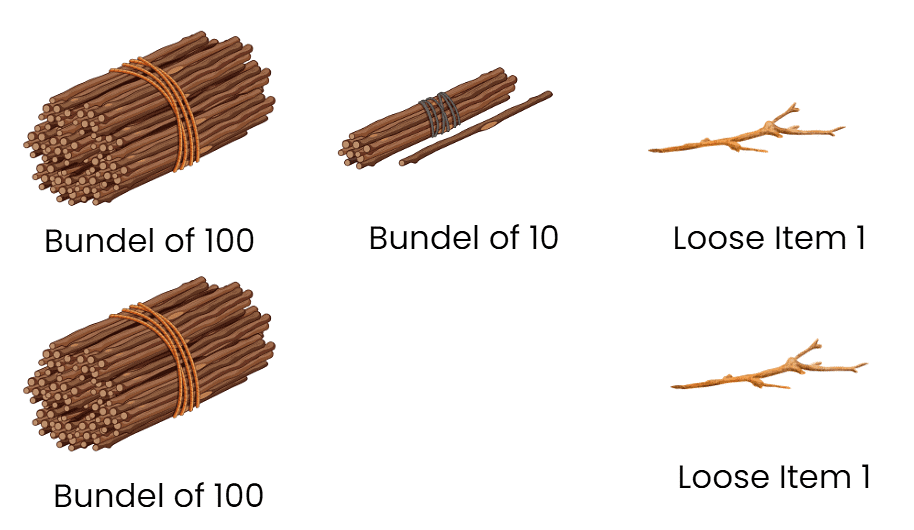Chapter Fun with Numbers Class 3 Notes Maths
| Table of contents |

|
| Numbers |

|
| Number Names |

|
| Jumping Numbers |

|
| Counting 10s |

|
| Counting 50s |

|
| Patterns |

|
| How many are these? |

|
Numbers
Numbers are symbols or representations used to quantify or count things. They help us understand quantities, measurements etc.
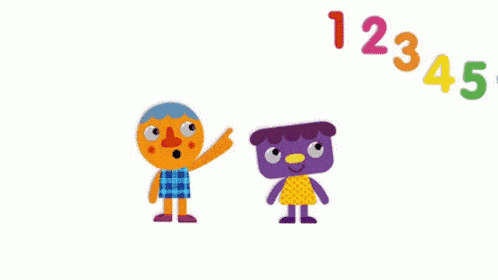
Number Names
A number name is simply the word representation of a number. For example:
- The number "1" can be represented by its number name, which is "one."
- The number "5" can be represented by its number name, which is "five."
- The number "10" can be represented by its number name, which is "ten."
- The number "100" can be represented by its number name, which is "one hundred."
- The number "1,000" can be represented by its number name, which is "one thousand."
- The number "10,000" can be represented by its number name, which is "ten thousand."
Number names are used in everyday language to communicate quantities, count objects, and express numerical concepts. They are an essential part of understanding and communicating numerical information.
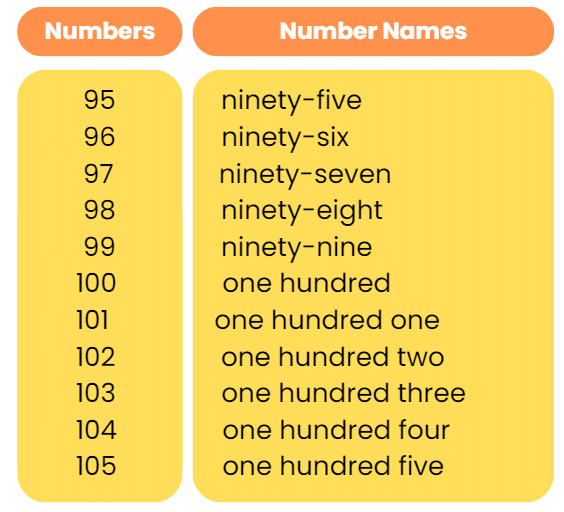
Jumping Numbers
Jumping numbers typically refer to sequences where the increments aren't consistent like in regular counting. For example, counting by twos (2, 4, 6, 8, ...) or by fives (5, 10, 15, 20, ...). Here are a few examples:
- Counting by Twos: 2, 4, 6, 8, 10, 12, ...
- Counting by Fives: 5, 10, 15, 20, 25, 30, ...
- Counting by Hundreds: 100, 200, 300, 400, 500, 600, ...
- Counting by Thousands: 1000, 2000, 3000, 4000, 5000, ...
These sequences involve "jumping" over numbers based on a specific increment, rather than counting each consecutive number.
Counting 10s
Counting by 10s involves adding 10 to each previous number.


Here's how it goes:
10, 20, 30, 40, 50, 60, 70, 80, 90, 100, 110, 120, 130,140, 150, 160, 170, 180, 190, 200. ...
Each number in the sequence is 10 more than the previous one. This pattern continues indefinitely, with each number being 10 greater than the one before it.
Counting 50s
Counting by 50s involves adding 50 to each previous number. Here's how it goes:

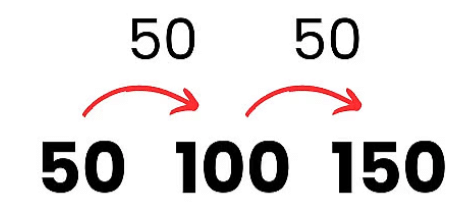
Here's how it goes:
50, 100, 150, 200, 250, 300, 350, 400, 450, 500, 550, 600, 650, ...
Each number in the sequence is 50 more than the previous one. This pattern continues indefinitely, with each number being 50 greater than the one before it.
Patterns
- Patterns can be observed in numbers by examining the difference between consecutive numbers.
- Patterns can be forward counting (increasing sequence) or backward counting (decreasing sequence).
- Imagine you have a sequence of numbers: 3, 6, 9, 12, 15, ... What's the pattern here?
To uncover the pattern, we examine the differences between consecutive numbers.
Here, the difference between each pair of numbers is 3.
It's like a magical step of 3 that we take to reach the next number.
So, we can say this pattern is a forward counting pattern with an increment of 3.
- Now, let's explore a different pattern: 100, 90, 80, 70, 60, ... Can you spot the pattern this time?
Again, we examine the differences between consecutive numbers.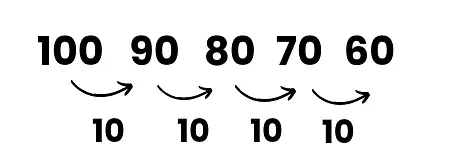 Here, the difference between each pair of numbers is 10. It's like taking a leap of 10 to move from one number to the next. So, this pattern is a backward counting pattern with a decrement of 10.
Here, the difference between each pair of numbers is 10. It's like taking a leap of 10 to move from one number to the next. So, this pattern is a backward counting pattern with a decrement of 10.
Solve the following:
Example 1: Sol: Forward means we will have to add to each number. Jumping 2 steps forward means we will have to add 2 to each number.
Sol: Forward means we will have to add to each number. Jumping 2 steps forward means we will have to add 2 to each number.
So, 52+2=54.
54+2= 56.
56+2=58.
58+2= 60.
The sequence will be 52, 54, 56, 58, 60.
Example 2:  Sol: Forward means to add. Jumping 5 steps forward means we have to add 5 to each number. So, 150+5= 155.
Sol: Forward means to add. Jumping 5 steps forward means we have to add 5 to each number. So, 150+5= 155.
155+5= 160.
160+5= 165.
165+5= 170.
The sequence will be 150, 155,160,165,170.
Example 3:  Sol: Backward means to subtract. So, to jump 2 steps backwards we will have to subtract 2 from each number.
Sol: Backward means to subtract. So, to jump 2 steps backwards we will have to subtract 2 from each number.
So, 390-2= 388
388-2= 386
386-2= 384
384-2= 382
The sequence will be 390, 388,386, 384, 382.
Note: Horizontal subtraction will be as same as vertical subtraction. Look at the explanation given below.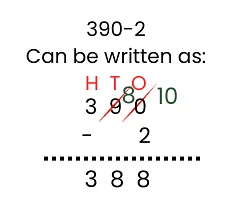 So after 390, the next number we get is 388.
So after 390, the next number we get is 388.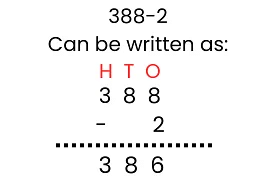 The next number we get is 386. Now we subtract 2 from 386.
The next number we get is 386. Now we subtract 2 from 386.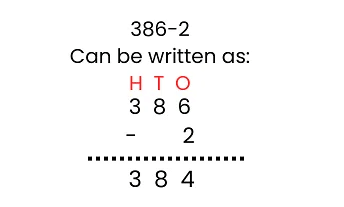 Now, for the final number we subtract 2 from 384.
Now, for the final number we subtract 2 from 384.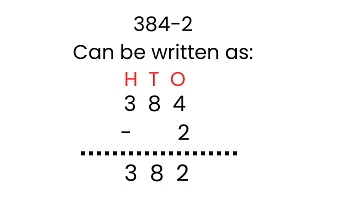
Example 4:
 Sol: Backward means to subtract. 10 steps backwards means we will have to subtract 10 from each number.
Sol: Backward means to subtract. 10 steps backwards means we will have to subtract 10 from each number.
So the sequence will be 1000, 990, 980, 970, 960.
How many are these?
- Bundles of 100: If we have some bundles where each bundle has 100 items, we count the number of bundles and multiply that by 100.
- Bundles of 10: If we have some bundles where each bundle has 10 items, we count the number of bundles and multiply that by 10.
- Loose items: If we have some loose items, we simply count them.
Then, we add the numbers we get from each group to find the total number of items.
For example:
- If we have 3 bundles of 100, that's 3×100=300
- If we have 5 bundles of 10, that's 5×10=505×10=50.
- If we have 7 loose items, that's simply 7.
So, we add: 300+50+7=357, That's the total number of items.
1. Tell the total amount of sticks.
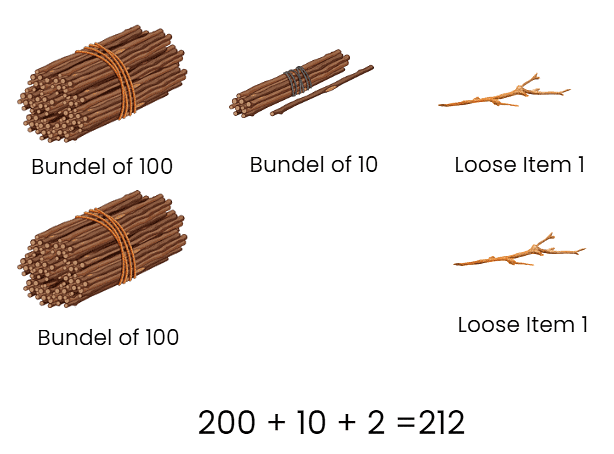 We can answer this easily. We have 2 bundles of 100. So we write 2 in hundreds place. We have 1 bundle of 10 sticks so we will write 1 in tens place. Then we look at single sticks, which are 2, so we write 2 in ones place. The total number of sticks we have is 212 or Two hundred and twelve.
We can answer this easily. We have 2 bundles of 100. So we write 2 in hundreds place. We have 1 bundle of 10 sticks so we will write 1 in tens place. Then we look at single sticks, which are 2, so we write 2 in ones place. The total number of sticks we have is 212 or Two hundred and twelve.2. Tell the total amount.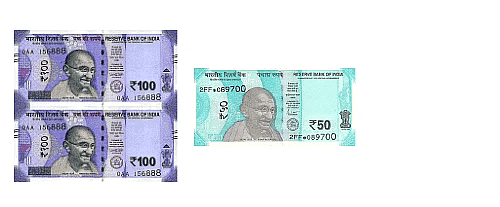
Sol: 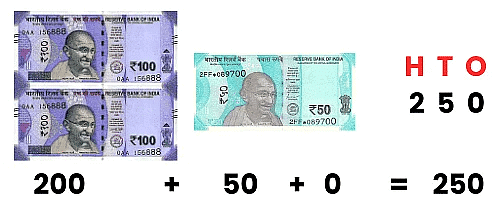 We have 2 notes of hundred, so we will write 2 in hundreds place and we have 1 note of 50, so we write 5 in tens place, meaning we have 5 times 10. We do not see any other note so we write 0 in one place. The total we get is 250 or Two hundred fifty.
We have 2 notes of hundred, so we will write 2 in hundreds place and we have 1 note of 50, so we write 5 in tens place, meaning we have 5 times 10. We do not see any other note so we write 0 in one place. The total we get is 250 or Two hundred fifty.
|
35 videos|119 docs|55 tests
|
FAQs on Chapter Fun with Numbers Class 3 Notes Maths
| 1. What are number names? |  |
| 2. What are jumping numbers? |  |
| 3. How do you count in 10s? |  |
| 4. How do you count in 50s? |  |
| 5. What are patterns in numbers? |  |

